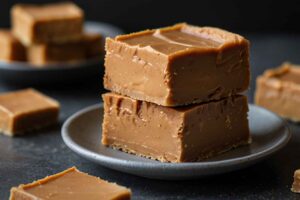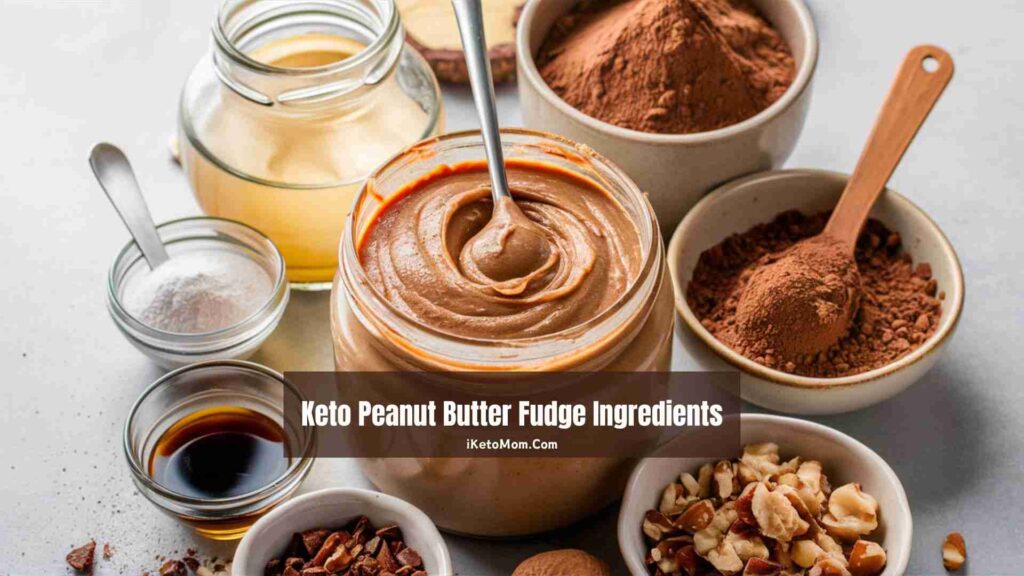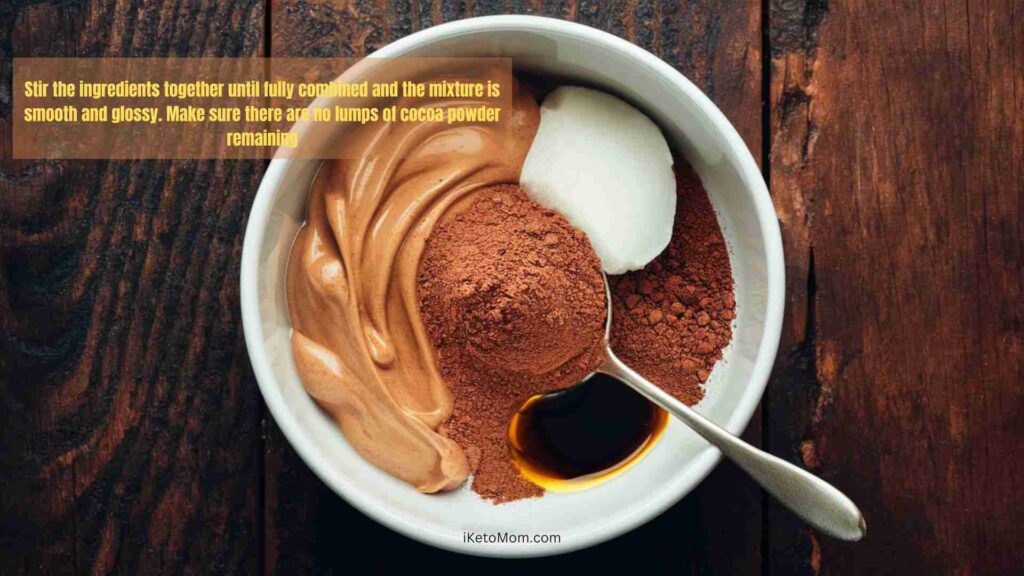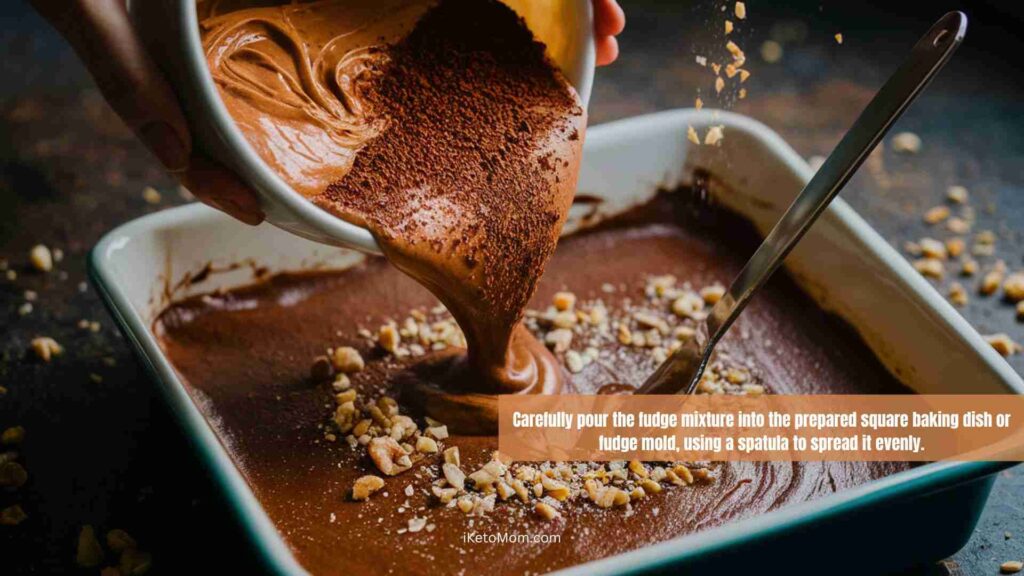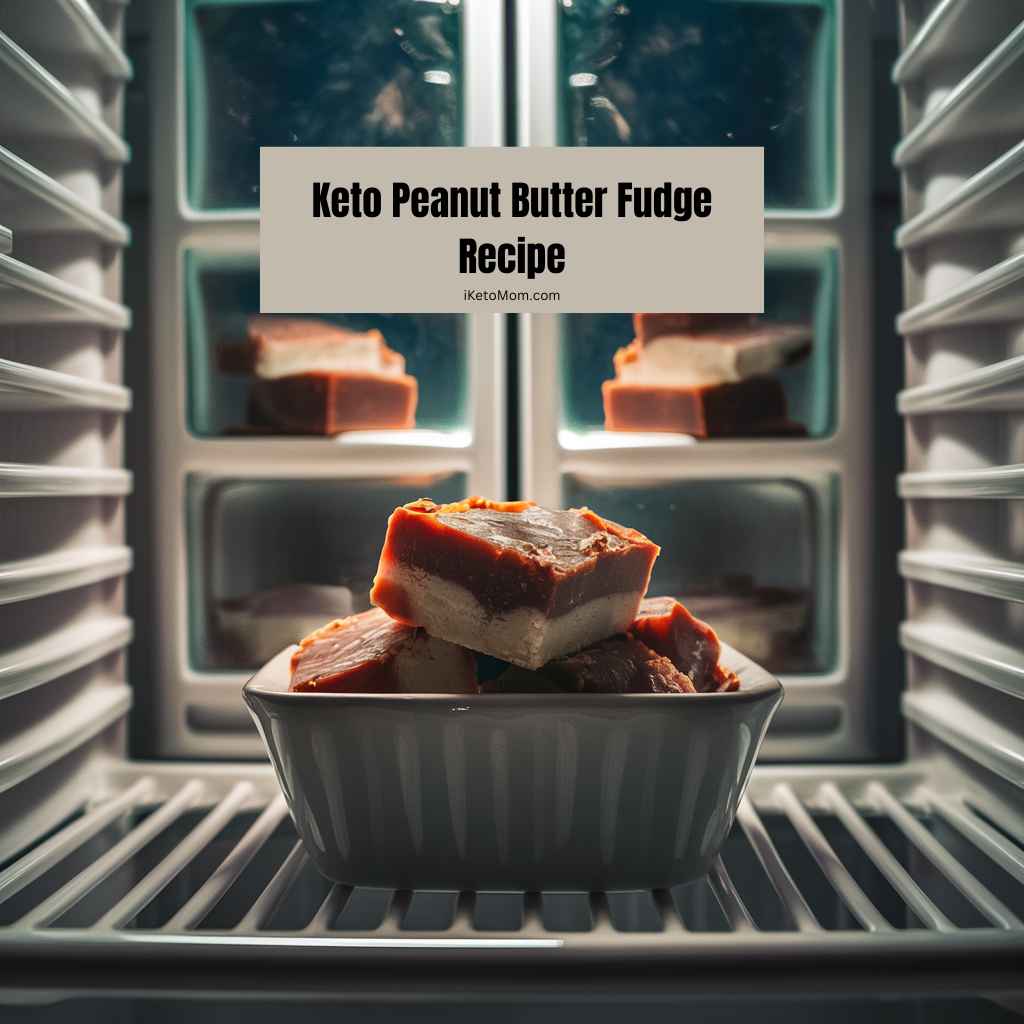This Keto Peanut Butter Fudge recipe offers a delicious and satisfying dessert option for those following a ketogenic lifestyle. Made with simple, low-carb ingredients like natural peanut butter, coconut oil, cocoa powder, and a keto-friendly sweetener, this fudge delivers rich flavor without the guilt of traditional sugary treats. With its creamy texture and decadent taste, it’s a perfect indulgence for anyone craving a sweet treat while staying true to their keto goals. Let’s enjoy Keto Chocolate Peanut Butter Fudge recipe.
Benefits of Keto Peanut Butter Fudge:
- Low-Carb: With minimal carbohydrates per serving, this fudge is suitable for those following a keto diet, allowing them to enjoy a sweet treat without disrupting their macronutrient goals.
- High in Healthy Fats: The combination of peanut butter and coconut oil provides a good source of healthy fats, which are essential for maintaining ketosis and promoting satiety.
- Sugar-Free: By using a keto-friendly sweetener like powdered erythritol, this fudge is free from added sugars, making it suitable for those looking to reduce their sugar intake or manage blood sugar levels.
- Quick and Easy to Make: With just a few simple ingredients and minimal preparation steps, this recipe can be whipped up in no time, making it a convenient option for satisfying sweet cravings on demand.
- Versatile: This fudge recipe can be easily customized with optional mix-ins like chopped nuts or sugar-free chocolate chips, allowing for endless flavor variations to suit individual tastes and preferences.
Keto Peanut Butter Fudge Recipe
Ingredients
1. Natural Peanut Butter (1 cup):
Natural peanut butter is made from ground peanuts without added sugars or hydrogenated oils. It provides a creamy texture and rich flavor to the fudge while also offering a good source of healthy fats and protein.
2. Coconut Oil (1/2 cup)
Coconut oil is a versatile and healthy fat that solidifies at room temperature, helping to give the fudge its firm texture. It adds a subtle coconut flavor and provides medium-chain triglycerides (MCTs), which are readily converted into ketones for energy on a keto diet.
3. Unsweetened Cocoa Powder (1/4 cup)
Unsweetened cocoa powder is derived from cocoa beans and is rich in antioxidants and flavonoids. It adds a deep chocolate flavor to the fudge without adding extra sugar or carbohydrates.
4. Powdered Erythritol (1/4 cup)
Powdered erythritol is a keto-friendly sweetener that provides sweetness without spiking blood sugar levels. It has zero calories and a negligible impact on blood sugar, making it an ideal choice for low-carb diets.
5. Vanilla Extract (1 teaspoon)
Vanilla extract enhances the flavor of the fudge with its sweet and aromatic notes. It adds depth to the overall taste profile without contributing significant calories or carbohydrates.
6. Salt (Pinch)
A pinch of salt helps to balance the sweetness of the fudge and enhance its flavors. It also serves to heighten the taste of the other ingredients.
With its blend of wholesome ingredients and optional substitutions, this Keto Peanut Butter Fudge recipe offers a deliciously satisfying treat that perfectly aligns with the principles of the ketogenic diet, ensuring a guilt-free indulgence for all.
Instructions
1. Preparation of Ingredients
- Gather all the necessary ingredients listed in the recipe.
- Measure out 1 cup of natural peanut butter, 1/2 cup of coconut oil, 1/4 cup of unsweetened cocoa powder, 1/4 cup of powdered erythritol (or preferred sweetener), 1 teaspoon of vanilla extract, a pinch of salt, and optional chopped nuts.
- Line a square baking dish or fudge mold with parchment paper for easy removal.
2. Melting and Mixing Steps:
- In a microwave-safe bowl or on the stovetop, melt the 1 cup of natural peanut butter and 1/2 cup of coconut oil together until smooth. Stir occasionally to ensure even melting.
- Once melted, add 1/4 cup of unsweetened cocoa powder, 1/4 cup of powdered erythritol (or preferred sweetener), 1 teaspoon of vanilla extract, and a pinch of salt to the melted peanut butter and coconut oil mixture.
- Stir the ingredients together until fully combined and the mixture is smooth and glossy. Make sure there are no lumps of cocoa powder remaining.
3. Pouring into Molds
- Carefully pour the fudge mixture into the prepared square baking dish or fudge mold, using a spatula to spread it evenly.
- If desired, sprinkle the optional chopped nuts on top of the fudge mixture, gently pressing them into the surface for better adherence.
4. Refrigeration
- Transfer the filled mold to the refrigerator to set for at least 2-3 hours, or until the fudge is firm to the touch.
- Once set, remove the fudge from the refrigerator and lift it out of the mold using the parchment paper.
- Place the fudge on a cutting board and cut it into squares or desired shapes using a sharp knife.
By following these step-by-step instructions and tips, you can easily create delicious Keto Peanut Butter Fudge with the perfect balance of flavor and texture, making it an irresistible treat for any occasion.
Optional Ingredient Substitutions
- Peanut Butter:
- Almond butter or any other nut butter can be substituted for peanut butter if desired. Ensure it’s unsweetened and preferably creamy for the best texture.
- Coconut Oil:
- Unsalted butter or ghee can be used as a substitute for coconut oil. Both options provide a creamy texture and richness to the fudge.
- Cocoa Powder:
- For a different flavor, you can use cacao powder instead of cocoa powder. Cacao powder tends to be less processed and may offer a more intense chocolate flavor.
- Erythritol:
- Other keto-friendly sweeteners like stevia or monk fruit sweetener can replace erythritol. Adjust the amount according to sweetness preference.
- Vanilla Extract:
- If vanilla extract is not available, vanilla bean paste or almond extract can be used as a substitute. Both alternatives add a pleasant flavor to the fudge.
- Salt:
- Any type of salt can be used, but if you prefer a specific flavor profile, consider using sea salt or Himalayan pink salt for a hint of mineral flavor.
- Chopped Nuts:
- Nuts are optional and can be omitted for a nut-free version of the fudge. Alternatively, other mix-ins like shredded coconut or sugar-free chocolate chips can be added for variation.
These ingredients and optional substitutions provide flexibility and customization options for creating the perfect Keto Peanut Butter Fudge to suit individual taste preferences and dietary needs.
The ketogenic diet, commonly known as keto, is a high-fat, low-carbohydrate eating plan designed to induce a metabolic state called ketosis. In ketosis, the body switches from using glucose as its primary fuel source to burning fat for energy. This shift in metabolism can lead to various health benefits, including weight loss, improved blood sugar control, and increased mental clarity. The keto diet typically consists of high-fat foods such as meats, fish, eggs, nuts, seeds, and healthy oils, while minimizing intake of carbohydrates, including sugars and starchy foods.
Keto Peanut Butter Fudge Nutrition Info
Nutrition facts table for the Keto Peanut Butter Fudge recipe, based on an estimated serving size of 1 square (assuming 16 servings in total):
| Nutrient | Amount Per Serving |
|---|---|
| Calories | 125-150 |
| Total Fat | 12g |
| – Saturated Fat | 7g |
| Total Carbohydrates | 3g |
| – Dietary Fiber | 1g |
| – Sugars | 1g |
| Protein | 3g |
Please note that these values are approximate and may vary depending on the specific ingredients used and the size of the servings. Additionally, the carbohydrate count may be lower if using erythritol or another low-carb sweetener.
Nutrition facts table for the individual ingredients used in the Keto Peanut Butter Fudge recipe, based on typical serving sizes:
| Ingredient | Serving Size | Calories | Total Fat | Saturated Fat | Total Carbohydrates | Fiber | Sugars | Protein |
|---|---|---|---|---|---|---|---|---|
| Natural Peanut Butter | 2 tbsp | 190 | 16g | 3g | 7g | 3g | 1g | 8g |
| Coconut Oil | 1 tbsp | 120 | 14g | 12g | 0g | 0g | 0g | 0g |
| Unsweetened Cocoa Powder | 1 tbsp | 12 | 1g | 0.5g | 3g | 2g | 0g | 1g |
| Powdered Erythritol | 1 tbsp | 0 | 0g | 0g | 4g | 0g | 0g | 0g |
| Vanilla Extract | 1 tsp | 12 | 0g | 0g | 0.6g | 0g | 0g | 0g |
| Salt | 1 pinch | 0 | 0g | 0g | 0g | 0g | 0g | 0g |
Tips for Best Results 🍽
- Use High-Quality Ingredients: Opt for natural peanut butter without added sugars or oils, and choose a high-quality coconut oil. Using good quality ingredients will enhance the flavor and texture of the fudge.
- Thoroughly Mix the Ingredients: Make sure to thoroughly mix the melted peanut butter and coconut oil with the cocoa powder, sweetener, vanilla extract, and salt until smooth and well combined. This ensures a consistent texture and flavor throughout the fudge.
- Adjust Sweetness to Taste: Taste the fudge mixture before pouring it into the mold and adjust the sweetness level by adding more powdered sweetener if needed. Keep in mind that some sweeteners may have different sweetness levels, so adjust accordingly.
- Be Mindful of Melting: When melting the peanut butter and coconut oil, be careful not to overheat them, as this can result in an oily texture. Heat them just until melted and smooth, stirring occasionally to ensure even melting.
- Allow Sufficient Refrigeration Time: Refrigerate the fudge for at least 2-3 hours, or until firm to the touch, to ensure it sets properly. Cutting into the fudge too early can result in a softer texture, so be patient and allow it to fully set.
- Consider Adding Optional Mix-Ins: Customize the fudge by adding optional mix-ins like chopped nuts or sugar-free chocolate chips for added flavor and texture. Sprinkle them on top of the fudge before refrigerating for best results.
- Store Properly: Store the fudge in an airtight container in the refrigerator to maintain its freshness and texture. It can also be stored in the freezer for longer shelf life, just be sure to thaw it before serving.
By following these tips, you can ensure that your Keto Peanut Butter Fudge turns out perfectly delicious every time!
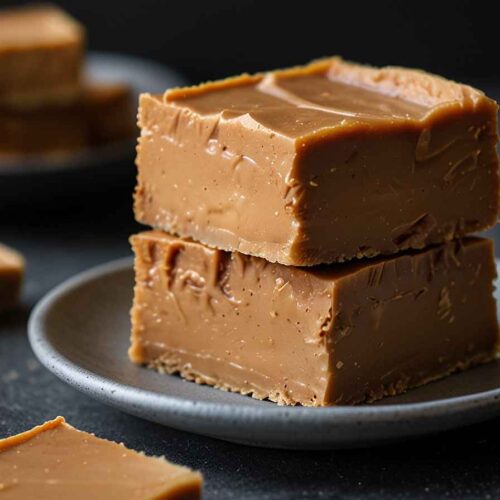
Keto Peanut Butter Fudge
Ingredients
- 1 Cup Natural Peanut Butter
- 1/2 Cup Coconut Oil
- 1/4 Cup Unsweetened Cocoa Powder
- 1/4 Cup Powdered Erythritol (or preferred sweetener)
- 1 tsp Vanilla Extract
- Pinch of salt
Optional Ingredients Substitutions
- Peanut Butter: Almond butter or any other nut butter
- Coconut Oil: Unsalted butter or ghee
- Cocoa Powder: Cacao powder
- Erythritol: Stevia or monk fruit sweetener
- Vanilla Extract: Vanilla bean paste or almond extract
- Salt: Sea salt or Himalayan pink salt
- Chopped Nuts: Shredded coconut or sugar-free chocolate chips
Instructions
- Prepare all necessary ingredients and measure them out accordingly. Line a square baking dish or fudge mold with parchment paper.
- Melt peanut butter and coconut oil together until smooth, either in a microwave-safe bowl or on the stovetop. Stir in cocoa powder, sweetener, vanilla extract, and salt until fully combined.
- Pour the mixture into the prepared baking dish or mold, ensuring it spreads evenly. Optionally, sprinkle chopped nuts on top and press gently into the mixture.
- Place the filled mold in the refrigerator and allow the fudge to set for 2-3 hours, or until firm to the touch.
- Once set, remove the fudge from the mold using the parchment paper. Cut into squares or desired shapes using a sharp knife.
- Serve and enjoy your delicious Keto Peanut Butter Fudge!
Notes
Delicious Topping Ideas
Here are some delicious topping ideas to enhance your Keto Peanut Butter Fudge:
1. Sugar-Free Chocolate Drizzle:
Melt sugar-free chocolate chips and drizzle over the fudge for an extra chocolatey touch. You can also sprinkle some chopped nuts on top for added crunch.
2. Toasted Coconut Flakes
Toasted coconut flakes add a delightful nutty flavor and crispy texture to the fudge. Simply toast the coconut flakes in a dry skillet until golden brown, then sprinkle them over the fudge.
3. Sea Salt Flakes
A sprinkle of sea salt flakes on top of the fudge enhances the sweetness and adds a satisfying contrast of flavors. It’s a simple yet elegant topping that elevates the fudge to a whole new level.
4. Crushed Nuts
Chop up some toasted nuts like pecans, almonds, or walnuts and sprinkle them generously over the fudge. The nuts add a delightful crunch and nutty flavor that pairs perfectly with the creamy texture of the fudge.
5. Keto-Friendly Caramel Sauce
Drizzle some keto-friendly caramel sauce over the fudge for a decadent and indulgent treat. You can make your own caramel sauce using sugar-free sweeteners like erythritol or purchase pre-made keto-friendly caramel sauce.
6. Fresh Berries
Top the fudge with a few fresh berries like raspberries, strawberries, or blueberries for a burst of freshness and natural sweetness. The vibrant colors of the berries also make for a visually appealing presentation
7. Whipped Coconut Cream
Whip up some coconut cream until light and fluffy, then dollop it on top of the fudge for a dairy-free and keto-friendly topping. You can sweeten the coconut cream with a touch of powdered erythritol or vanilla extract if desired.
These delicious topping ideas add extra flavor, texture, and visual appeal to your Keto Peanut Butter Fudge, making it even more irresistible for indulging in guilt-free sweet treats!
FAQ
How many carbs are in homemade peanut butter fudge?
The number of carbs in homemade peanut butter fudge can vary depending on the ingredients used and the recipe followed. However, if you’re using ingredients like natural peanut butter, coconut oil, cocoa powder, powdered erythritol (or another keto-friendly sweetener), and vanilla extract, you can calculate the approximate carb count by adding up the carbs in each ingredient and dividing by the number of servings.
For example, if a recipe makes 12 servings and each serving contains:
- 2 tablespoons (32g) of natural peanut butter: approximately 3 grams of net carbs
- 2 tablespoons (28g) of coconut oil: 0 grams of net carbs
- 2 tablespoons (10g) of cocoa powder: approximately 3 grams of net carbs
- 2 tablespoons (24g) of powdered erythritol: approximately 0 grams of net carbs
- 1 teaspoon (4.2g) of vanilla extract: approximately 1 gram of net carbs
You would add these together to get a total of around 7 grams of net carbs per serving. However, it’s essential to note that these values are approximate and may vary based on the specific brands and types of ingredients you use. Always double-check the nutritional information on your ingredients and adjust the calculations accordingly.
The basic ingredients for Fathead dough typically include shredded mozzarella cheese, cream cheese, almond flour, and sometimes an egg and baking powder. These ingredients are melted together and then mixed to form a dough-like consistency. The dough can then be rolled out and shaped according to the desired recipe.
Fathead dough has gained popularity among those following low-carb or ketogenic diets because it is significantly lower in carbohydrates compared to traditional dough made with wheat flour. Additionally, it provides a good source of healthy fats from the cheese and almond flour, making it a satisfying option for those looking to reduce their carb intake while still enjoying their favorite baked goods.
Is peanut butter ok on a keto diet?
Yes, peanut butter can be included in a keto diet, but it’s essential to choose the right type and consume it in moderation.
Natural peanut butter, which contains only peanuts and possibly salt, is generally a better option for a keto diet compared to commercial peanut butter varieties that may contain added sugars and hydrogenated oils. These added sugars can increase the carbohydrate content, making them less suitable for a keto diet.
When consuming peanut butter on a keto diet, it’s crucial to be mindful of portion sizes, as peanuts do contain some carbohydrates. However, they also provide healthy fats and protein, making them a satisfying and nutritious option when consumed in moderation.
What are the benefits of peanut butter fudge?
Peanut butter fudge, especially when made with keto-friendly ingredients, can offer several potential benefits:
- High in Healthy Fats: Peanut butter fudge typically contains healthy fats from ingredients like natural peanut butter and coconut oil. These fats can provide sustained energy and promote satiety, helping you feel full and satisfied after indulging in a small portion.
- Low in Carbs: When made with keto-friendly sweeteners like powdered erythritol or stevia, peanut butter fudge can be relatively low in carbohydrates compared to traditional fudge recipes. This can make it suitable for individuals following a ketogenic or low-carb diet.
- Source of Protein: Peanut butter is a good source of protein, which is essential for muscle repair, immune function, and overall health. Including protein-rich foods like peanut butter in your diet can help you meet your daily protein needs.
- Provides Essential Nutrients: Peanut butter contains essential nutrients such as vitamin E, magnesium, and potassium. These nutrients play various roles in the body, including supporting heart health, muscle function, and bone health.
- Satisfies Sweet Cravings: Peanut butter fudge offers a delicious way to satisfy sweet cravings without consuming excessive amounts of sugar. By using keto-friendly sweeteners, you can enjoy the sweetness of fudge without experiencing the blood sugar spikes associated with traditional sugar-laden treats.
- Easy to Make: Homemade peanut butter fudge is relatively easy to make and requires minimal ingredients. This makes it a convenient option for satisfying your sweet tooth without spending hours in the kitchen.
How long does peanut butter fudge last?
The shelf life of peanut butter fudge depends on several factors, including the ingredients used, how it’s stored, and whether it contains any perishable components. Here’s a general guideline:
- Room Temperature: Peanut butter fudge can typically last at room temperature for about 1 to 2 weeks if stored in an airtight container. However, if the fudge contains ingredients like dairy or eggs that require refrigeration, it should be stored accordingly.
- Refrigeration: Storing peanut butter fudge in the refrigerator can extend its shelf life to about 2 to 3 weeks. Make sure to keep it in an airtight container or wrap it tightly in plastic wrap to prevent it from drying out or absorbing odors from other foods in the fridge.
- Freezing: Peanut butter fudge can also be frozen for longer-term storage. It’s best to wrap individual pieces tightly in plastic wrap or aluminum foil, then place them in a freezer bag or airtight container. Properly stored, peanut butter fudge can last in the freezer for up to 3 months. When ready to enjoy, allow the fudge to thaw in the refrigerator overnight before serving.
Keep in mind that these are general guidelines, and the shelf life of your peanut butter fudge may vary depending on the specific recipe and storage conditions. Always use your best judgment and inspect the fudge for any signs of spoilage, such as mold, off smells, or changes in texture, before consuming.

I’m Priscilla Swahn, a registered dietitian with a master’s degree in nutritional sciences. With over a decade of experience in holistic nutrition, I specialize in creating delicious keto recipes to help you enjoy a healthy lifestyle. On iKetoMom, you’ll find a variety of recipes for every meal—hearty breakfasts, satisfying lunches, mouthwatering dinners, indulgent desserts, and refreshing drinks. My recipes make keto living easy and enjoyable for the whole family. Featured in EatingWell and MindBodyGreen, I also collaborate with health centers and corporate companies to share my expertise. Join me and discover the joy of keto cooking!

